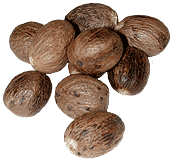Nutmeg and its sister spice mace both come from the nutmeg tree Myristica fragrans. This tree grows in the Molucca Islands and elsewhere in Indonesia. It is now cultivated commercially in the West Indies, especially Grenada, for its spices. The international trade in nutmeg seems to have originated with Arab traders and it was unknown in the classical world. The early European spice trade was remarkable for the sheer ferocity of the European nations that struggled with each other for control of this lucrative market. The apparently insignificant nutmeg that is found in almost every kitchen today was once fought over by competitors from Venice, Genoa, the Netherlands, Portugal and England. In the stampede most of the native inhabitants of the Banda Islands in the Indonesian archipelago (the source of the nutmeg tree) were wiped out. Nutmeg
from
The Encyclopedia of Psychoactive Substances
by Richard Rudgley
Little, Brown and Company (1998)Nutmeg has been considered to be a useful medicine in a number of Asian societies. Among the Arabs it has been used to treat digestive problems and also been valued as an aphrodisiac; the Indians used it to combat asthma and heart complaints and still use it as a sedative. Nicholas Culpeper (1616-54), the famous English herbalist, attributes to nutmeg the capacity to induce sleep delirium. William Salmon, on the other hand, said that the oil of mace or nutmegs, if rubbed on the genitals, excited sexual passion (thereby echoing the Arabs' use of its aphrodisiac qualities). Nutmeg also was seen as having magical properties and is one of the ingredients of a magical perfume described in the most famous of all the grimoires, or black books of the sorcerers, The Key of Solomon the King. The use of nutmeg as a magical medicine continued far into the twentieth century in England. The belief that carrying nutmeg in the pocket could cure various complaints has been recorded from various parts of the country. In Yorkshire it was considered as the best way to relieve rheumatic pain, in Lincolnshire it was said to cure backache and in Devon it was eaten to clear up boils. Elsewhere it was used by gardeners as a prophylactic measure against the occupational hazard of backache. As late as 1966 a Hampshire coalman who suffered from lumbago was told to carry nutmeg, and when he did so he swore he never suffered from it again. Nutmeg was also believed to be lucky in gambling. A newspaper article from the mid-1960s reported that an individual sprinkled nutmeg powder on their football pools coupon and, on the advice of a gypsy, left it for twenty-four hours before posting it.
Nutmeg's intoxicating properties have long been known in Europe but it never seems to have been a culturally significant psychoactive substance and most early reports concern its accidental rather than intentional ingestion for use as a drug. Its more prominent role in modern times has not been due in the main to an increased desire for it as it has a very lowly status in the hierarchy of drugs, owing to its uncomfortable side effects such as nausea and stomach cramps. Rather it has been a substitute for other substances that for one reason or another were unavailable or unaffordable. Thus prisoners, soldiers, seamen and struggling musicians were among its users. A jazz musician who played regularly with the legendary saxophonist Charlie Parker (known as 'Bird') recalled that: 'Bird introduced this nutmeg to the guys. It was a cheap and legal high. You can take it in milk or Coca-Cola. The grocer across the street came over to the club owner and said, "I know you do all this baking because I sell from eight to ten nutmegs a day." And the owner came back and looked at the bandstand and there was a whole pile of nutmeg boxes.'' In 1946, before his conversion to Islam, Malcolm X used nutmeg whilst in jail when his supplies of marijuana ran out. In his autobiography he wrote: 'I first got high in Charlestown [prison] on nutmeg. My cellmate was among at least a hundred nutmeg men who, for money or cigarettes, bought from kitchen worker inmates penny matchboxes full of stolen nutmeg. I grabbed a box as though it were a pound of heavy drugs. Stirred into a glass of cold water, a penny matchbox full of nutmeg had the kick of three or four reefers.' When the authorities became aware of such uses of nutmeg it was removed from many prison kitchens.
Although nutmeg has been demoted to a 'pseudo-hallucinogen' by many authorities, a self-experiment by Paul Devereux, a writer on the alignments of prehistoric sites, seems to indicate that its psychoactive effects can nevertheless be quite dramatic. In July 1989 Devereux took two level teaspoons of ground nutmeg and then went to bed, sprinkling nutmeg essential oil on his pillow and sheets. He began to feel the minor discomforts often associated with nutmeg use - mild nausea, irritation of the skin and so on. When he had been asleep for a few hours he had a dream in which he was travelling down a tunnel and flying at ever increasing speeds. He became fully conscious when in full flight and travelled over a landscape. During the flight he passed close to a tree and snatched at its leaves, feeling 'the pull of the branches and the foliage digging into my hand'. In other words the tactile sense was fully operative. He decided to terminate the journey by retracing his path and arriving back at his starting point, and opened his eyes. His hallucinations were thus both visual and tactile but he experienced no auditory or olfactory sensations during the experience.

HOMESoma
Betel nut
Orthorexia
Comfort foods
Nutrigenomics
Food supplements
The science of dieting
Psychoactive Hotlinks
The Abolitionist Project
Diet and mental health
Mood, food and cognition
Reprogramming Predators
Nutmeg seeds and anxiety
Is nutmeg a potential aphrodisiac?
